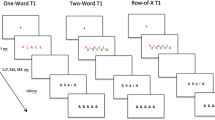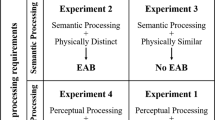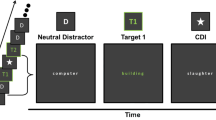Abstract
When the second of two targets (T2) is presented temporally close to the first target (T1) in a rapid serial visual presentation stream, accuracy to identify T2 is markedly reduced—an attentional blink (AB). While most individuals show an AB, Dale and Arnell (Atten Percept Psychophys 72(3):602–606, 2010) demonstrated that individual differences in dispositional attentional focus predicted AB performance, such that individuals who showed a natural bias toward the global level of Navon letter stimuli were less susceptible to the AB and showed a smaller AB effect. For the current study, we extended the findings of Dale and Arnell (Atten Percept Psychophys 72(3):602–606, 2010) through two experiments. In Experiment 1, we examined the relationship between dispositional global/local bias and the AB using a highly reliable hierarchical shape task measure. In Experiment 2, we examined whether three distinct global/local measures could predict AB performance. In both experiments, performance on the global/local tasks predicted subsequent AB performance, such that individuals with a greater preference for the global information showed a reduced AB. This supports previous findings, as well as recent models which discuss the role of attentional breadth in selective attention.








Similar content being viewed by others
Notes
Previous studies have shown that an overall global processing advantage often emerges when using traditional global/local stimuli (e.g., Navon, 1981). However, other studies (e.g., Kimchi & Palmer, 1982) have shown that this global advantage can be modulated by the relative size of the stimuli and by the number of local elements included in a global figure (i.e., the density of the figure). This is problematic for individual differences research, as this means that participants can become artificially biased toward global or local stimuli unless the stimuli are equated in terms of perceptual salience (e.g., Fredrickson & Branigan, 2005; Kimchi, 1992; Kimchi & Palmer, 1982). As such, we used the stimuli of Dale and Arnell (2013a, Experiment 1) for both Experiments 1 and 2 as these have been shown to have equally salient global and local levels, such that the stimuli are roughly global/local neutral.
One of the additional tasks was an unrelated cognitive maze task used as a filler and the other was a Navon task. In addition to having two blocks of AB trials, 120 AB trials in both blocks were further subdivided into 10 mini-blocks of 12 trials each, with a 1 min Navon letter task interspersed. The Navon task had no effect on the AB trials for the first versus second block, and there were no significant differences among these mini-blocks, F < 1, thus the data were ultimately collapsed both within block and across block.
When conducting an individual differences study, it is not ideal to counterbalance the tasks’ order across participants. Performance on the tasks may differ somewhat based on the order in which they are presented; therefore a participant’s relative score on a given task could be confounded with order variability if order was counterbalanced or random. This confound can be removed in individual differences studies using a constant task order, which is why all participants ran the tasks in the same order here.
Note that while there are several issues surrounding the dichotomization of variables (see MacCallum, Zhang, Preacher, & Rucker, 2002), the data were split here as a supplement to the correlational analyses that were already conducted, and to allow for a better visualization of the pattern of results.
References
Arend, I., Johnston, S., & Shapiro, K. (2006). Task-irrelevant visual motion and flicker attenuate the attentional blink. Psychonomic Bulletin & Review, 13(4), 600–607. doi:10.3758/BF03193969.
Arnell, K. M., Stokes, K. A., MacLean, M. H., & Gicante, C. (2010). Executive control processes of working memory predict attentional blink magnitude over and above storage capacity. Psychological Research, 74(1), 1–11. doi:10.1007/s00426-008-0200-4.
Arnell, K. M., & Stubitz, S. M. (2010). Attentional blink magnitude is predicted by the ability to keep irrelevant material out of working memory. Psychological Research, 74(5), 457–467. doi:10.1007/s00426-009-0265-8.
Christianson, S. Å., & Loftus, E. F. (1990). Some characteristics of people’s traumatic memories. Bulletin of the Psychonomic Society, 28(3), 195–198.
Chun, M.M., & Potter, M.C. (1995). A two-stage model for multiple target detection in rapid serial visual presentation. Journal of Experimental Psychology: Human Perception and Performance, 21, 109–127. doi:10.1037/0096-1523.21.1.109
Colzato, L. S., Spapé, M. M., Pannebakker, M. M., & Hommel, B. (2007). Working memory and the attentional blink: blink size is predicted by individual differences in operation span. Psychonomic Bulletin & Review, 14(6), 1051–1057. doi:10.3758/BF03193090.
Dale, G., & Arnell, K. M. (2010). Individual differences in dispositional focus of attention predict attentional blink magnitude. Attention, Perception, & Psychophysics, 72(3), 602–606. doi:10.3758/APP.72.3.602.
Dale, G., & Arnell, K. M. (2013a). Investigating the stability of and relationships among global/local processing measures. Attention, Perception, & Psychophysics, 75(3), 394–406. doi:10.3758/s13414-012-0416-7.
Dale, G., & Arnell, K. M. (2013b). How reliable is the attentional blink? Examining the relationships within and between attentional blink tasks over time. Psychological Research, 77(2), 99–105. doi:10.1007/s00426-011-0403-y.
Dale G., & Arnell, K.M. Lost in the forest, stuck in the trees: dispositional global/local bias is resistant to exposure to high and low spatial frequencies. PLOS ONE (in Press).
Dale, G., Dux, P.E., & Arnell, K.M. (2013). Individual differences within and across attentional blink tasks revisited. Attention, Perception, & Psychophysics, 75(3), 456–467. doi:10.3758/s13414-012-0415-8.
Dell’Acqua, R., Dux, P. E., Wyble, B., & Jolicœur, P. (2012). Sparing from the attentional blink is not spared from structural limitations. Psychonomic Bulletin & Review, 19, 232–238. doi:10.3758/s13423-011-0209-3.
Deruelle, C., Rondan, C., Salle-Collemiche, X., Bastard-Rosset, D., & Da Fonséca, D. (2008). Attention to low- and high-spatial frequencies in categorizing facial identities, emotions and gender in children with autism. Brain and Cognition, 66, 115–123. doi:10.1016/j.bandc.2007.06.001.
Di Lollo, V., Kawahara, J. I., Ghorashi, S. S., & Enns, J. T. (2005). The attentional blink: resource depletion or temporary loss of control? Psychological Research, 69(3), 191–200. doi:10.1007/s00426-004-0173-x.
Dux, P. E., & Marois, R. (2008). Distractor inhibition predicts individual differences in the attentional blink. PLoS ONE, 3(10), e3330. doi:10.1371/journal.pone.0003330.
Dux, P. E., & Marois, R. (2009). The attentional blink: a review of data and theory. Attention, Perception, & Psychophysics, 71(8), 1683–1700. doi:10.3758/APP.71.8.1683.
Fredrickson, B. L. (2001). The role of positive emotions in positive psychology: the broaden-and-build theory of positive emotions. American Psychologist, 56(3), 218–226. doi:10.1037/0003-066X.56.3.218.
Fredrickson, B. L., & Branigan, C. (2005). Positive emotions broaden the scope of attention and thought-action repertoires. Cognition & Emotion, 19(3), 313–332.
Gasper, K., & Clore, G. L. (2002). Attending to the big picture: mood and global versus. local processing of visual information. Psychological Science, 13(1), 34–40. doi:10.1111/1467-9280.00406.
Green, C. S., & Bavelier, D. (2003). Action video game modifies visual selective attention. Nature, 423, 534–537. doi:10.1038/nature01647.
Jolicoeur, P. (1999). Dual-task interference and visual encoding. Journal of Experimental Psychology: Human Perception and Performance, 25, 596–616. doi:10.1037/0096-1523.25.3.596.
Jolicoeur, P., & Dell’Acqua, R. (1998). The demonstration of short-term consolidation. Cognitive Psychology, 36, 138–202. doi:10.1006/cogp.1998.0684.
Kawahara, J. (2009). When do additional distractors reduce the attentional blink? Journal of Experimental Psychology: Human Perception and Performance, 35(4), 1043–1061. doi:10.1037/a0012727.
Kellie, F. J., & Shapiro, K. L. (2004). Object-file continuity predicts attentional blink magnitude. Perception and Psychophysics, 66, 692–712.
Kimchi, R. (1992). Primacy of wholistic processing and global/local paradigm: a critical review. Psychological Bulletin, 112(1), 24–38. doi:10.1037/0033-2909.112.1.24.
Kimchi, R., & Palmer, S. E. (1982). Form and texture in hierarchically constructed patterns. Journal of Experimental Psychology: Human Perception and Performance, 8(4), 521–535. doi:10.1037/0096-1523.8.4.521.
MacCallum, R. C., Zhang, S., Preacher, K. J., & Rucker, D. D. (2002). On the practice of dichotomization of quantitative variables. Psychological Methods, 7(1), 19–40. doi:10.1037/1082-989X.7.1.19.
MacLean, M. H., & Arnell, K. M. (2010). Personality predicts temporal attention costs in the attentional blink paradigm. Psychonomic Bulletin & Review, 17(4), 556–562. doi:10.3758/PBR.17.4.556.
MacLean, M. H., & Arnell, K. M. (2011). Greater attentional blink magnitude is associated with higher levels of anticipatory attention as measured by alpha event-related desynchronization (ERD). Brain Research, 1387, 99–107. doi:10.1016/j.brainres.2011.02.069.
MacLean, M. H., & Arnell, K. M. (2013). Individual differences in electrophysiological responses to performance feedback predict AB magnitude. Cognitive, Affective & Behavioral Neuroscience, 13(2), 270–283. doi:10.3758/s13415-012-0140-8.
MacLean, M. H., Arnell, K. M., & Busseri, M. A. (2010). Dispositional affect predicts temporal attention costs in the attentional blink paradigm. Cognition and Emotion, 24(8), 1431–1438.
Martens, S., Munneke, J., Smid, H., & Johnson, A. (2006). Quick minds don’t blink: electrophysiological correlates of individual differences in attentional selection. Journal of Cognitive Neuroscience, 18(9), 1423–1438. doi:10.1162/jocn.2006.18.9.1423.
Martens, S., & Valchev, N. (2009). Individual differences in the attentional blink. Experimental Psychology, 56(1), 18–26. doi:10.1027/1618-3169.56.1.18.
Minear, M., & Park, D. C. (2004). A lifespan database of adult facial stimuli. Behavior Research Methods, Instruments, & Computers, 36(4), 630–633.
Navon, D. (1977). Forest before trees: the precedence of global features in visual perception. Cognitive Psychology, 9(3), 353–383. doi:10.1016/0010-0285(77)90012-3.
Navon, D. (1981). The forest revisited: more on global precedence. Psychological Research, 43(1), 1–32. doi:10.1007/BF00309635.
Nieuwenstein, M. R., & Potter, M. C. (2006). Temporal limits of selection and memory encoding a comparison of whole versus partial report in rapid serial visual presentation. Psychological Science, 17, 471–475.
Nunnally, J. C. (1978). Psychometric theory (2nd ed.). New York: McGraw-Hill.
Olivers, C. N., & Meeter, M. (2008). A boost and bounce theory of temporal attention. Psychological Review, 115(4), 836–863. doi:10.1037/a0013395.
Olivers, C. N., & Nieuwenhuis, S. (2005). The beneficial effect of concurrent task- irrelevant mental activity on temporal attention. Psychological Science, 16(4), 265–269. doi:10.1111/j.0956-7976.2005.01526.x.
Olivers, C. N., & Nieuwenhuis, S. (2006). The beneficial effects of additional task load, positive affect, and instruction on the attentional blink. Journal of Experimental Psychology: Human Perception and Performance, 32(2), 364–379. doi:10.1037/0096-1523.32.2.364.
Raymond, J. E., Shapiro, K. L., & Arnell, K. M. (1992). Temporary suppression of visual processing in an RSVP task: an attentional blink? Journal of Experimental Psychology: Human Perception and Performance, 18(3), 849–860. doi:10.1037/0096-1523.18.3.849.
Rowe, G., Hirsh, J. B., & Anderson, A. K. (2007). Positive affect increases the breadth of attentional selection. Proceedings of the National Academy of Sciences, 104(1), 383–388.
Shapiro, K., Schmitz, F., Martens, S., Hommel, B., & Schnitzler, A. (2006). Resource sharing in the attentional blink. Neuroreport, 17, 163–166.
Spearman, C. (1904). The proof and measurement of association between two things. The American Journal of Psychology, 15, 72–101.
Taatgen, N. A., Juvina, I., Schipper, M., Borst, J. P., & Martens, S. (2009). Too much control can hurt: a threaded cognition model of the attentional blink. Cognitive Psychology, 59(1), 1–29. doi:10.1016/j.cogpsych.2008.12.002.
Vermeulen, N. (2010). Current positive and negative affective states modulate attention: an attentional blink study. Personality and Individual Differences, 49(5), 542–545. doi:10.1016/j.paid.2010.04.003.
Acknowledgments
This work was funded by grants from the National Sciences and Engineering Research Council (NSERC), the Canadian Foundation for Innovation (CFI), and the Ontario Innovation Trust (OIF) to the second author. We thank Blaire Dube, Baris Bagcilar, and Tabatha Methot for their assistance with data collection.
Author information
Authors and Affiliations
Corresponding author
Rights and permissions
About this article
Cite this article
Dale, G., Arnell, K.M. Multiple measures of dispositional global/local bias predict attentional blink magnitude. Psychological Research 79, 534–547 (2015). https://doi.org/10.1007/s00426-014-0591-3
Received:
Accepted:
Published:
Issue Date:
DOI: https://doi.org/10.1007/s00426-014-0591-3




